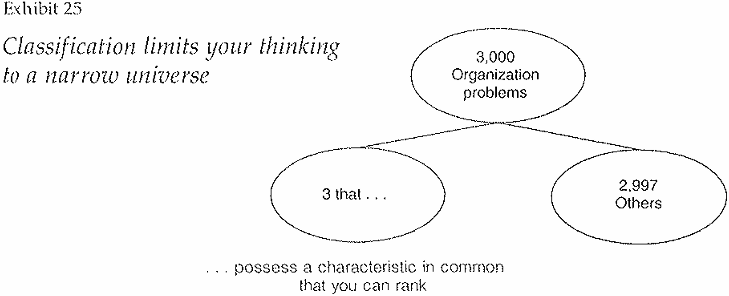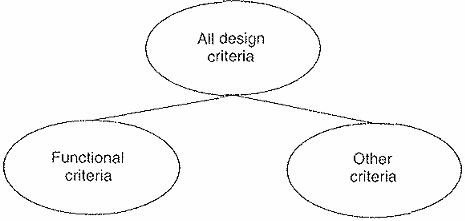


 Grammar
Grammar
 Tenses
Tenses
 Present
Present
 Past
Past
 Future
Future
 Parts Of Speech
Parts Of Speech
 Nouns
Nouns
 Verbs
Verbs
 Adverbs
Adverbs
 Adjectives
Adjectives
 Pronouns
Pronouns
 Pre Position
Pre Position
 Preposition by function
Preposition by function 
 Preposition by construction
Preposition by construction
 Conjunctions
Conjunctions
 Interjections
Interjections
 Grammar Rules
Grammar Rules
 Linguistics
Linguistics
 Semantics
Semantics
 Pragmatics
Pragmatics
 Reading Comprehension
Reading Comprehension
 Teaching Methods
Teaching Methods|
Read More
Date: 2024-10-02
Date: 2024-09-15
Date: 2024-09-09
|
In classifying, when you say, "The company has three problems," your mind automatically separates these three problems from all other possible problems the company has or could have, creating a bifurcate structure like that shown in Exhibit 25. The two classes formed are by definition collectively exhaustive, and are of course meant to be mutually exclusive.

You prove they are mutually exclusive by defining quite specifically what characteristic they have in common, and then searching your knowledge to make sure you have included in your grouping all known items with this same characteristic. Then you place them in the order of the degree to which each possesses the characteristic by which you classified it-presenting the strongest one first.
Many people ask me whether, having determined the relative weight of the points, you always have to put the strongest one first. They point out that it would be more dramatic to put the weakest one first and work up to the strongest one. It would indeed be more dramatic, but being dramatic is an emotional consideration, not a logical one, and thus becomes a matter of style. In same cases you may quite legitimately decide to reverse the order for greater emotional impact.
In most cases, however, you put the strongest point first. Thus, suppose you write the following:
Telecom's billing system should be designed to be broadly useful
I. Meet outside customer needs
2. Satisfy internal management requirements
3. Conform to outside regulations
Although the system must meet all three functional needs, the order here implies that the cust0mer is more important to satisfy than the outside regulator. And underneath that assessment was this automatic classification:

It turns out that order based on class groupings is much less widely used in business writing than is either time order or structural order. This is not to say that classifying does not go on. Classifying is a ubiquitous human habit, and people classify everything they see as soon as they see it, simply by naming what it is. But they do not limit themselves to creating classes of points that are alike only by virtue of their possessing a characteristic in common. They also consider ideas to be alike, and therefore classifiable, if they were derived front the same process or drawn front the same structure.
This is a perfectly legitimate thing to do, provided that you are clear about the source of your grouping and reflect accordingly the order it imposes. Here, for example, is a point supported by three "reasons"…
You should not consider a Vendor Capture strategy (Vendor Capture is trading your warehouse space in return for vendor exclusivity)
1. Your warehouses are neither large enough nor ideally located
2. Even if they were, the approach requires double handling
3. Even if you accept that, the possible admin-mileage savings are negligible
…but the order implies an existing structure (you have the warehouse, within which you have the process, from which you calculate the savings).
|
|
|
|
دراسة: حفنة من الجوز يوميا تحميك من سرطان القولون
|
|
|
|
|
|
|
تنشيط أول مفاعل ملح منصهر يستعمل الثوريوم في العالم.. سباق "الأرنب والسلحفاة"
|
|
|
|
|
|
|
الطلبة المشاركون: مسابقة فنِّ الخطابة تمثل فرصة للتنافس الإبداعي وتنمية المهارات
|
|
|